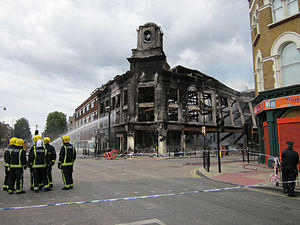Urban violenceThe U.K. August 2011 riots could have been predicted
Researchers studying urban violence have developed a new method which can help city authorities to assess the conditions where conflict could potentially tip into violence; Participatory Violence Appraisal (PVA), used in Kenya and Chile, could have helped to anticipate the tipping points that led to last summer’s riots in cities across the United Kingdom, the researchers say

Burned-out hulk of stores and apartments after night of rioting // Source: wikipedia.org
A University of Manchester team researching urban violence has developed a new method which can help city authorities to assess the conditions where conflict could potentially tip into violence.
Participatory Violence Appraisal (PVA), used in Kenya and Chile, could have helped to anticipate the tipping points that led to last summer’s riots in cities across the United Kingdom, say the team based at the University’s Global Urban Research Center (GURC) .
The project challenges stereotypes of causes of violence, such as poverty, youth bulges and political exclusion, finding that it often arises through sudden, discontinuous tipping points, sometimes building into “chains.”
A University of Manchester release reports that standard data usually focus on crime but do not address gender-based violence — which is often invisible — or ethnic, political, and economic violence which are often accepted as “normal.”
A common set of factors, the researchers also say, identify when otherwise well run civil mechanisms, which manage day to day conflict, cannot cope and different forms of violence emerge.
GURC director Professor Caroline Moser, who led the study, said: “Urban violence is an increasingly significant but much misunderstood global phenomenon. But there are no blueprints for when conflict tips into violence; each situation has different underlying causes and our research is about trying to understand them.
“Participatory Violence Appraisal helps us to more fully understand the circumstances where conflict can tip over into generalized violence — and could actually make us reassess what constitutes a violent city.
“PVA samples the views of focus group participants and reveals that much violence is missed by city authorities because it is hidden or part of acceptable behavior.
“It allows poor groups to identify the extent to which violence-related problems affect their well-being, as well as assessing the cause and consequences of violence.
“It’s likely the method would have helped us understand what was going on before conflict tipped into violence in some U.K. cities last August.”
The project, funded jointly by the Economic and Social Research Council and the government’s Department for International Development, focused on four cities known for violent conflict. The teams in Santiago, Chile and Nairobi, Kenya used PVA, while the other two were Dili, Timor and Patna, India, using different techniques.
- In Santiago they found that violence is not confined to poor areas
- In Patna, women were identified as the principle victims of violence, with alcohol consumption identified as the principle cause of violence
- In Dili, social jealousy and historical problems among the political elite was the most important cause
- In Nairobi, political violence predominated. Tipping points from conflict to violence included political campaigns, evictions, rent rises, abusive language by politicians and police and election rigging.
Moser added: “One type of violence can often lead to another so our research is also about understanding how to these break chains. In the August riots, the rapid intervention of civil society, the police and local government meant that the chain appeared to be broken early on — though without carrying out PVA, we can’t know if any further types of violence, such as economic or gender-based violence resulted.”
The teams in each of the cities made recommendations based on the data they collected, which they presented to international agencies such as WHO and UNICEF and a range of donors in Geneva last week.
Their project was described as “being close to the perfect research project” by Dr. Duncan Green, Head of Research at Oxfam GB.
Violent cities
In Dili, more than 100 buildings were destroyed, an estimated 21,000 Dili residents fled the city, and five people were killed in 2006. In 2008 an unspecified number of people were beaten and hacked to death with machetes in Nairobi following Kenya’s disputed election. Santiago has seen a radical rise in reported instances of violence against women and Patna has reportedly witnessed a major decline in violence during the past half decade, following fifteen years of lawlessness.
Common factors identified by the team
Factors identifying when otherwise well run civil mechanisms, which manage day to day conflict, cannot cope and different forms of violence emerge:
- Lack of public space where different social groups can interact leads to ‘hotspots’
- Dysfunctional land tenure systems and land sub-markets closely associated with violence
- Multiple and competing forms of authority within a city.
- Exclusionary forms of neo-liberal governance creates city where particular social groups lose out
The case of Nairobi
The project studied the conditions of three slums in Nairobi: Kawangware, Kibera, and Mukuru using PVA. Though political violence in Nairobi, for example, was the dominant form at 26 percent of the total, domestic violence — which is often invisible — was the second most common at 19 percent.
Ethnic and economic violence, both accepted by the community as “normal,” each constituted 18 percent of the total. These are all significant and previously unrealized figures.
See more information at the Urban Tipping Point Web site.
